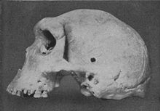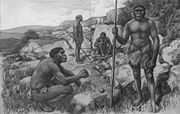
Homo rhodesiensis
Encyclopedia
Homo rhodesiensis is a hominin species described from the fossil Kabwe skull. Other morphologically
-comparable remains have been found from the same, or earlier, time period in southern Africa (Hopefield or Saldanha), East Africa (Bodo, Ndutu, Eyasi, Ileret
) and North Africa (Salé, Rabat, Dar-es-Soltane, Djbel Irhoud, Sidi Aberrahaman, Tighenif). These remains were dated between 300,000 and 125,000 years old.
Another specimen "the hominid from Lake Ndutu" may approach 400,000 years old, and Clarke in 1976 classified it as Homo erectus
. Undirect cranial capacity estimate is 1100 ml. Also supratoral sulcus morphology and presence of protuberance as suggested by Philip Rightmire : give the Nudutu occiput an appearance which is also unlike that of Homo Erectus but Stinger 1986 pointed that thickened iliac pillar is typical for Homo erectus.
.jpg)
 In Africa, there is a distinct difference in the Acheulian tools made before and after 600,000 years ago with the older group being thicker and less symmetric and the younger being more extensively trimmed. This may be connected with the appearance (some 300,000 years later) of Homo rhodesiensis in the archaeological record at this time who may have contributed this more sophisticated approach.
In Africa, there is a distinct difference in the Acheulian tools made before and after 600,000 years ago with the older group being thicker and less symmetric and the younger being more extensively trimmed. This may be connected with the appearance (some 300,000 years later) of Homo rhodesiensis in the archaeological record at this time who may have contributed this more sophisticated approach.
Rupert Murrill has studied the relations between Archanthropus skull of Petralona (Chalcidice
, Greece
) and Rhodesian Man. Most current experts believe Rhodesian Man to be within the group of Homo heidelbergensis
though other designations such as Homo sapiens arcaicus and Homo sapiens rhodesiensis have also been proposed. According to Tim White
, it is probable that Homo rhodesiensis was the ancestor of Homo sapiens idaltu
(Herto Man), which would be itself at the origin of Homo sapiens sapiens. No direct linkage of the species can so far be determined.
Morphology (biology)
In biology, morphology is a branch of bioscience dealing with the study of the form and structure of organisms and their specific structural features....
-comparable remains have been found from the same, or earlier, time period in southern Africa (Hopefield or Saldanha), East Africa (Bodo, Ndutu, Eyasi, Ileret
Ileret
Ileret is a village in Marsabit District, Eastern Province, Kenya. It is located in Northern Kenya, on the eastern shore of Lake Turkana, north of Sibiloi National Park and near the Ethiopian border. Administratively, Ileret is a part of a ward of the same name, which is part of North Horr...
) and North Africa (Salé, Rabat, Dar-es-Soltane, Djbel Irhoud, Sidi Aberrahaman, Tighenif). These remains were dated between 300,000 and 125,000 years old.
Another specimen "the hominid from Lake Ndutu" may approach 400,000 years old, and Clarke in 1976 classified it as Homo erectus
Homo erectus
Homo erectus is an extinct species of hominid that lived from the end of the Pliocene epoch to the later Pleistocene, about . The species originated in Africa and spread as far as India, China and Java. There is still disagreement on the subject of the classification, ancestry, and progeny of H...
. Undirect cranial capacity estimate is 1100 ml. Also supratoral sulcus morphology and presence of protuberance as suggested by Philip Rightmire : give the Nudutu occiput an appearance which is also unlike that of Homo Erectus but Stinger 1986 pointed that thickened iliac pillar is typical for Homo erectus.
.jpg)

Rupert Murrill has studied the relations between Archanthropus skull of Petralona (Chalcidice
Chalcidice
Chalkidiki, also Halkidiki, Chalcidice or Chalkidike , is a peninsula in northern Greece, and one of the regional units of Greece. It is part of the region of Central Macedonia. The autonomous Mount Athos region is part of the peninsula, but not of the regional unit...
, Greece
Greece
Greece , officially the Hellenic Republic , and historically Hellas or the Republic of Greece in English, is a country in southeastern Europe....
) and Rhodesian Man. Most current experts believe Rhodesian Man to be within the group of Homo heidelbergensis
Homo heidelbergensis
Homo heidelbergensis is an extinct species of the genus Homo which may be the direct ancestor of both Homo neanderthalensis in Europe and Homo sapiens. The best evidence found for these hominins date between 600,000 and 400,000 years ago. H...
though other designations such as Homo sapiens arcaicus and Homo sapiens rhodesiensis have also been proposed. According to Tim White
Tim White (anthropologist)
Tim D. White is an American Paleoanthropologist and Professor of Integrative Biology at the University of California, Berkeley. He is most famous for his work on Lucy as Australopithecus afarensis with discoverer Donald Johanson.-Career:White was born in Los Angeles County, California...
, it is probable that Homo rhodesiensis was the ancestor of Homo sapiens idaltu
Homo sapiens idaltu
Homo sapiens idaltu is an extinct subspecies of Homo sapiens that lived almost 160,000 years ago in Pleistocene Africa. is from the Saho-Afar word meaning "elder or first born"....
(Herto Man), which would be itself at the origin of Homo sapiens sapiens. No direct linkage of the species can so far be determined.
See also
- List of fossil sites (with link directory)
- List of hominina (hominid) fossils (with images)

